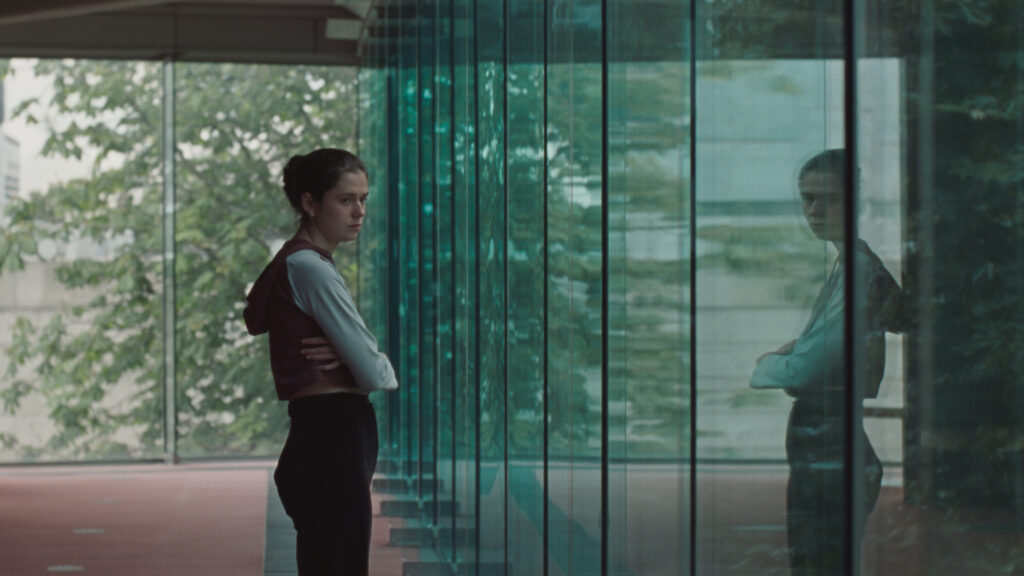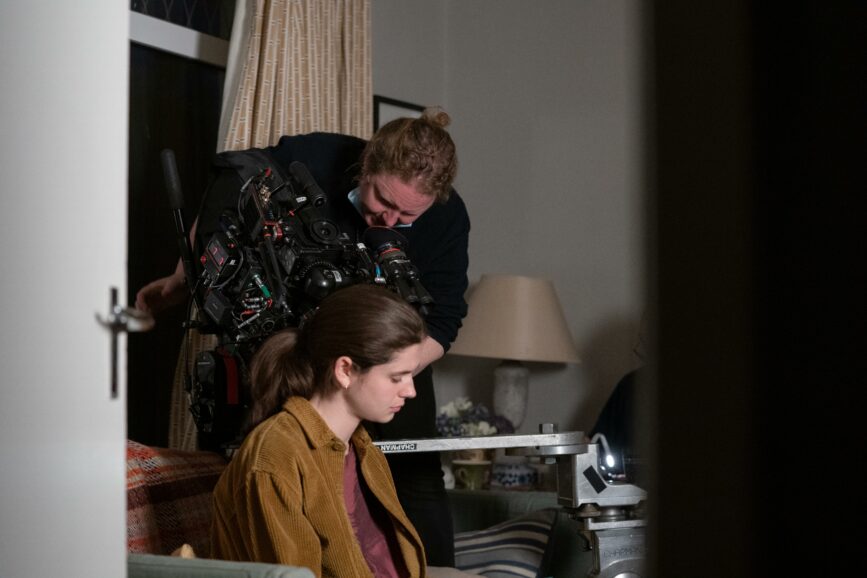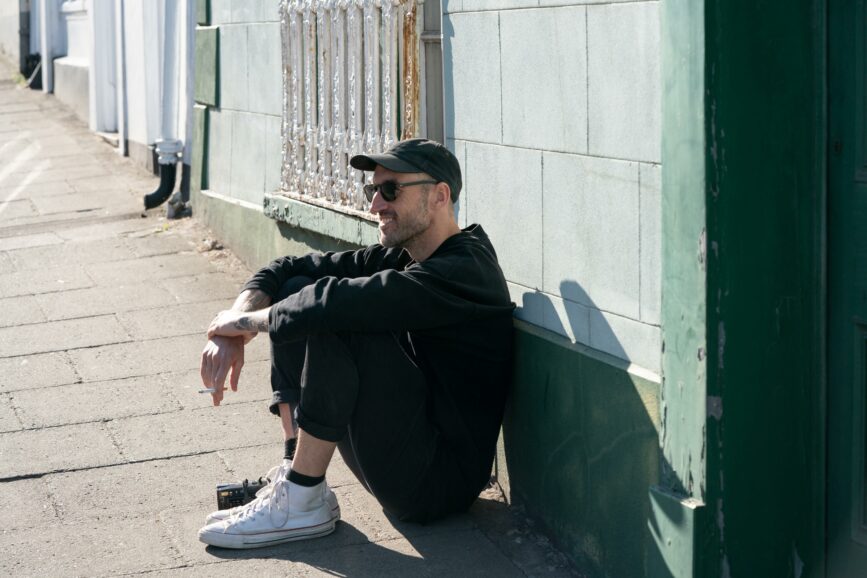CONVERSATIONS WITH CREATIVES
Naturalism, softness, and elegance were at the fore for cinematographers Suzie Lavelle BSC ISC and Bobby Shore when establishing the appropriate tone to successfully translate novel Conversations with Friends into a BBC Three series.
Helping bring Sally Rooney’s critically acclaimed book Conversations with Friends to the screen alongside director Lenny Abrahamson (Normal People, Room, Frank) was a “great privilege” for cinematographers Suzie Lavelle BSC ISC and Bobby Shore. But aside from being an enriching creative process, the experience had a positive and profound impact on Shore and the way he will approach future productions, teaching him to be diligent when selecting his next long form projects.
“It was one of the best experiences I’ve had, and it gave me a lot of perspective about the people I want to collaborate with and the productions I want to work on. It taught me you don’t need to work on a massive scale of show to feel fulfilled from a creative or career standpoint,” he says. “It’s all about the people and I can’t thank Suzie, Lenny, and second block director Leanne Welham enough for bringing me on board. I’ll gladly take a quiet, intimate drama with nice, respectful people over a massive show where you can become a cog in the wheel.”

In 2019, as Lavelle and Abrahamson finished translating another of Rooney’s captivating tomes, Normal People, for the screen, the director handed her the novel Conversations with Friends and invited her to join him on another invigorating and inspiring journey. “I loved working on Normal People with Lenny and the production company Element so much and had admired his work as an Irish director long before that,” says Lavelle. “So, there was no question when he asked me to shoot another series.”
Conversations With Friends follows college student Frances as she navigates her relationship with friend and ex-girlfriend Bobbi and the complications and temptation that results from an unexpected connection with married couple Nick and Melissa. At first Lavelle worked with Rooney’s book as source material rather than a script and engaged in discussions with Abrahamson about how best to guarantee the series felt natural and how to approach a production with four lead characters opposed to Normal People’s two protagonists.
COVID shutdowns brought with them additional time to explore references such as Never Rarely Sometimes Always (2020) for palette, tone, subjectivity, and stillness; Pawel Pawlikowski films including Ida (2013) and Cold War (2018); and Sean Durkin’s Martha Marcy May Marlene (2011) for its quiet filmmaking, palette, subjectivity, and use of long lenses to isolate characters.

“We also looked at the series I Know This Much Is True which, like Conversations with Friends, was shot 2-Perf 35mm and was a useful reference in terms of its field of view,” says Lavelle.
Evolving the look from Normal People, Abrahamson wanted to step the camera back a little, shoot slightly wider, and adopt portrait photography with less severe fall off. “We wanted to keep that naturalism, softness of the lenses, and some of that proximity to the cast, but also wanted to make changes, so we weren’t repeating the same thing. And while Normal People was captured on Alexa, we wanted to shoot Conversations on film.”
Lavelle chose 35mm 2-Perf partly to make the series “feel a bit more 16mm, a bit flatter. So, the field of view of our 35mm was 1.6 times bigger than Super 16. And with that format, it felt you could make two shots equal, so two characters within one frame could carry the same amount of weight.”

Abrahamson’s brief was always to keep the cinematography simple, elegant, effortless, and to aim for naturalistic lighting and skin tones. This was often achieved by lighting from outside windows and “trusting the film to do a lot of the work.” As the director also did not want to feel the camera and the filmmaker, this helped the crew move more freely and with fewer monitors.
Having set the visual tone for the series with Abrahamson, Lavelle embarked on lensing episodes one to five, eleven, and twelve, with episodes six to ten captured by fellow cinematographer Shore. “When I saw the initial email from my agent about the project I was taken aback,” says Shore. “Conversations with Friends, working with Suzie and Lenny, shooting 35mm, and this is the cast? This must be a mistake? I jumped at the chance.”
Due to the care, patience, and respect for the craft that was shown throughout the shoot from the HODs down, Shore found the production to be “a wonderful change of pace – feeling those steering the ship were really listening to the ideas being brought to the table.”

Rather than focusing on technical specifics, conversations between Lavelle and Shore aimed at establishing and maintaining a consistency of style were based on feeling and responding to the actors, tone, and vibe on set. “One of the most crucial pieces of information Suzie imparted was highlighting the little one eighths of a page scene where it says, ‘Frances walks here,’ or ‘Frances looks out of the window.’ She advised me to pay extra close attention to them because she knows the way Lenny likes to cut, lingering on those shots for a lot longer.”
Lavelle elaborates: “In the 25- to 30-minute episode format of the series, there is less plot to drive and more room for mood and tone, so you want to give a lot of options in the edit to build that mood which all happens in those tiny one eighths of a page. These could be read as transitional, but they’re not. They’re all about the moments alone with the characters.”
Never leading or instructing the viewer what they should see was the mantra throughout, a process Abrahamson refers to as “active watching” and “providing a space to let the viewer figure it out.” Shore was also inspired by the director and Lavelle’s method of “figuring things out” in prep. “It was incredible to watch them have that freedom to really feel out a scene on set,” he says. “After blocking the scene and shooting the first two shots, they might decide it wasn’t working and start from scratch. It was refreshing to see that much care and specificity going into the way each scene was filmed.”

Space to experiment
When shooting much of the Dublin-based narrative in Belfast, due to the available funding for the project, the crew soon discovered that some areas looked quite different to Ireland’s capital city. “And because Sally’s writing details iconic locations in Dublin, we had to work out where it was essential to see Dublin and where we could cheat in Belfast,” says Lavelle.
Shooting at two sizeable sets built at Loop Studios in Belfast required care to be taken to ensure the lighting looked natural and the transition from the real exterior to the set was invisible. The crew also needed to allow the cast freedom to move around the space by lighting through windows rather than placing lights on the floor. When shooting in such spaces, working with collaborators such as 1st ADs Sean Griffin and Owen Magee, who are masters of scheduling and “help facilitate freedom on the floor”, was essential.
When capturing a small number of sequences in Dublin, the lack of crowds and number of those people who were wearing masks outdoors during the pandemic was challenging. In both blocks the cinematographers strived to lay the texture of the city, using long lenses to help plant the characters within the city.

The book sees some of the narrative play out in the south of France, but following a recce, Abrahamson was not sure it felt like the right location to shoot. Having decided to film in Greece instead, another COVID lockdown prevented them from shooting there. “So, Croatia was chosen, mostly over Zoom, which is always terrifying,” says Lavelle. “And even though the villa we chose was more difficult to access than expected, in the end it was such an incredible location that it made it worthwhile.”
Production designer Anna Rackard assisted in the smooth running of the process by gathering a vast collection of reference photos. “Anna’s so collaborative and loves to experiment and rework ideas,” says Lavelle. “We would discuss colour palettes at length, and she would attend some of our camera tests.”

The first of those camera tests primarily determined the format and saw Lavelle, focus puller Job Reineke and Maiya Rose form a COVID-free unit to carry out tests inside Lavelle’s house and shoot night work at the end of her road.
“That test footage went all the way into post, with Gary Curran at Outer Limits grading and editor Nathan Nugent cutting it and adding sound,” says Lavelle. “This was then presented to Lenny and Element, demonstrating why we felt that look, achieved shooting on film, was best. Everyone loved it and backed the decision which was fantastic. For a production company to be so supportive of us shooting 35mm was special.”
When camera tests began, Lavelle sent Curran references which they graded, either remotely or together. “We then shared a broad range of still references and the work of Irish painters such as Paul Henry,” says Lavelle. “All the way through the shoot, Gary was my quality control if I was worried about something, either focus or exposure related. We also looked at how far the BBC would let us go in terms of grain and aberration.”

Playful production techniques
As principal photography approached, Lavelle repeated a process she likes to incorporate when shooting the first block of any show. She gathered the cast, director, and some crew in one of the spaces filming would take place and lit it as close as possible to how it would be illuminated during the shoot.
“This allows us to start testing, invite wardrobe to try out looks and the art department to experiment with colours on the walls, and get the cast and director in to play and see which lenses suit each character,” she says. “It’s relaxed and playful and takes the heat out of day one because you’re all on the set, chatting and breaking the ice with the actors. Getting all the creative HODs involved in that process and starting a productive dialogue lets me discover what they like, what they don’t, and how they envisage the colour palette.”
Having enjoyed the softness the Canon K35 lenses delivered for Normal People, test shoots confirmed to Abrahamson that they should be selected once again. These were used in conjunction with the Arricam LT, with the camera package provided by Belfast-based Acorn. Lavelle’s camera choice was partly governed by the “low-key nature of the performance” and “the importance of capturing the quiet and delicate dialogue.”

“We couldn’t be in a situation where the camera makes so much noise you can’t hear the dialogue, so the only system I felt we could use was an LT due to the lack of sound it makes,” says Lavelle. “We would be shooting a lot of handheld so its small size and the fact the mags hang at the back was helpful.”
Shore welcomed the simplicity and beauty of shooting on film due to the low-key, honest texture and palette that formed the foundation of the look which Lavelle and colourist Gary Curran had created in prep and was based on a Kodak 2383 print stock emulation LUT produced for Normal People.
“It was so liberating to just shoot and trust what your eyes were seeing, and that’s what it’s going to look like on film,” says Shore. “When it came to the debate around film versus digital, I used to be of the mind of ‘whatever works.’ If digital is what the director wants, you can make it work and make it look like film if needed.

“But within a week of working on this series I was a total convert. Film creates such an interesting tone and texture and the workflow on set is so special. It feels like there is such intention behind every setup, and that came from the top down on this production.”
Lavelle shot at 2.8 or 2-2.8 split to use some of the sharper part of the lens, a decision which initially daunted Shore when shooting on film. “But then I realised how easy it is to light at that stop,” he says. “It has a nice quality and texture and a little shallower depth of field than I was expecting, but I think it really helped.”
During this process Lavelle felt fortunate to work alongside focus puller Conor Hammond, admitting the job was not easy for a focus puller because so much was handheld and so much could change within each take, made even more complicated by not being able to pull off a monitor.

“It’s hard to find really good film drama focus pullers such as Conor,” she says. “He was amazing, as were loaders Scott Jamieson and Gavin McKay. And as our local production team in Belfast had never worked on film, it was beneficial to have local crew who could guide them through that process.”
The series was shot exclusively on Kodak Vision3 500T 5219 as testing proved it to be the stock that “held the texture best, boasted a beautiful grain, and produced slightly desaturated colours.” Processing, scanning, and graded film dailies were handled by Cinelab.
As Lavelle knew they would frequently need to shoot with available light at night for the exteriors, the 500T stock was also the wisest choice in terms of the low contrast and colour rendition.
“When we started the project and I learnt two episodes would be set in Croatia, I toyed with the idea of changing the stock, partly because of the bright sunlight and difficulty viewing if you need to ND a lot,” she says. “But when we went on a recce it just felt wrong to change anything. I’d never visited Croatia, but I could instantly see the tones – the blue of the sea and the warm rocks – were really unique and a beautiful ‘70s cinematic look was produced when captured on 500T. So, we decided to stay with that stock and just got used to all the ND filtration and learned how to use the video tap to display a better picture.”

From the outset Lavelle and Abrahamson decided against working with a broad palette, opting for one that was “more muted and desaturated with no big primary or popping colours.” Much of the tonal work was also achieved through production and costume design.
“Lorna Mugan, our costume designer, works so well with production designer Anna. We’d send location photos and she’d start thinking about the costume and palette in relation to that location and the interior spaces,” says Lavelle.
“Although there weren’t strict rules about palette, we also talked about the idea of embracing white or lighter walls in the student worlds we sometimes saw Frances and Bobbi in. This was something I would be slightly scared of shooting digitally but shooting it on film made me much happier.”

Being responsive
Lavelle and Shore worked closely with gaffers Simon Magee and later Dominic Palgan to determine how the locations would be illuminated, with all lighting equipment supplied by PKE Lighting. Lavelle, who generally lights with tungsten, focused on how to allow enough light through the windows into the sets whilst still “keeping it soft” shooting at 2.8 on the 500T.
“This required some testing to determine the quantity of light we would need. It turned out we needed a hell of a lot of light because we were softening at the window using heavy diffusion,” she says. “Our fixtures were predominantly tungsten aside from about 40 SkyPanel Space Lights which we rigged into the ceiling in Frances and Bobbi’s apartment set for added ambience.”

Lavelle experimented with new techniques while lighting Nick of Melissa’s house – a large grey space which was difficult to light because the walls were 18% grey and absorbed light. “I didn’t want to rig inside, especially because we were shooting handheld and wanted to give the actors space. So, I used a Wendy light on a crane behind the set, which I’ve never used in the studio before. It was brilliant and made it possible to create aberrations and highlights in places that were hard to achieve this effect such as through the glass conservatory.”
Shore agrees that there is “something special” about approaching and lighting sets in the way you would a location. “It takes a lot of power to make the lighting look naturalistic, but once you achieve that, it’s not worth rigging lights in the corners of every room.”
As much as technique was essential in the success of the series, for Shore, it was also “a reminder to treat the technical side of the process as wallpaper and be intuitive and responsive to what’s happening on the floor in front of you. It reinforced how important it is as a DP to be on set, close to the director and actors.”

This intimate approach which saw Lavelle and Shore operating – often with only the focus puller, the boom op, director, and script supervisor in the room – was also crucial.
“Every day I learned so much about storytelling. Watching Lenny work with cast taught me so much creating empathy within characters,” says Lavelle. “The whole experience was a rewarding learning curve, and just being on film, and trusting in film, was wonderful.”

















